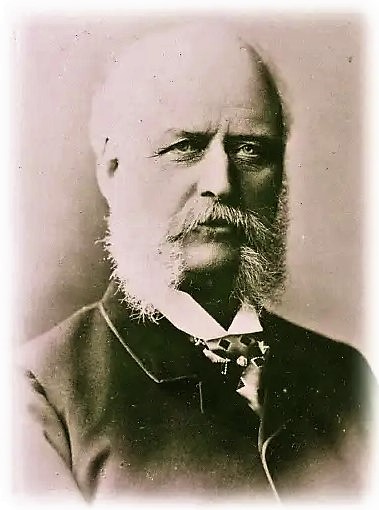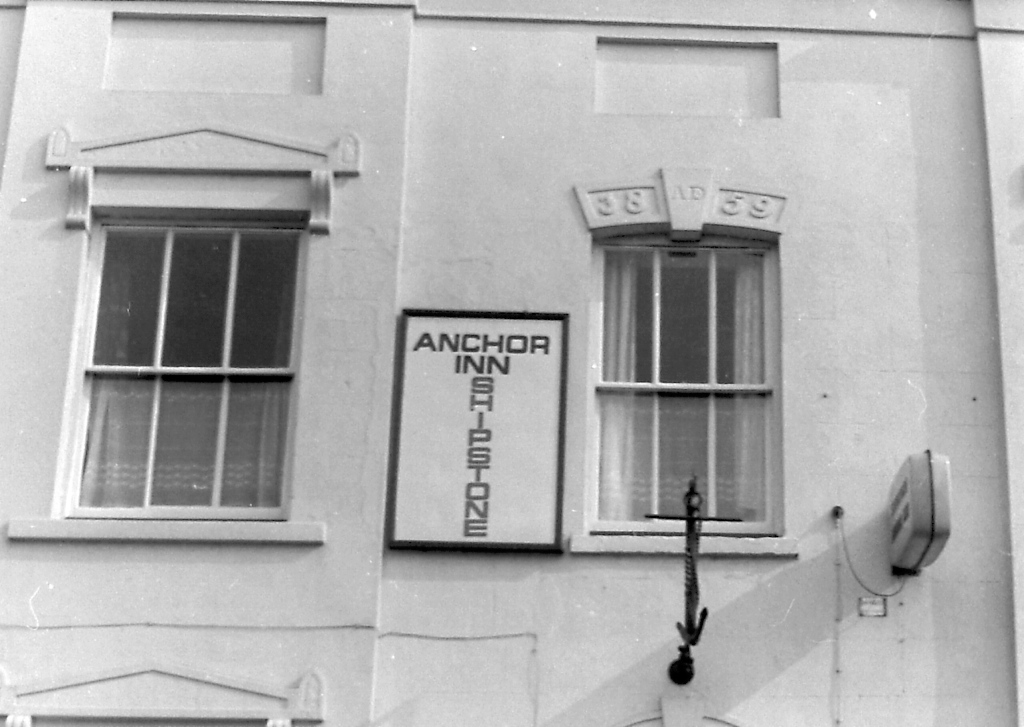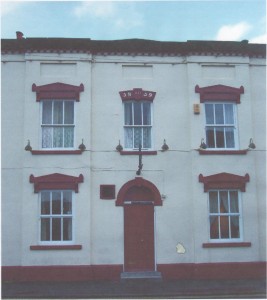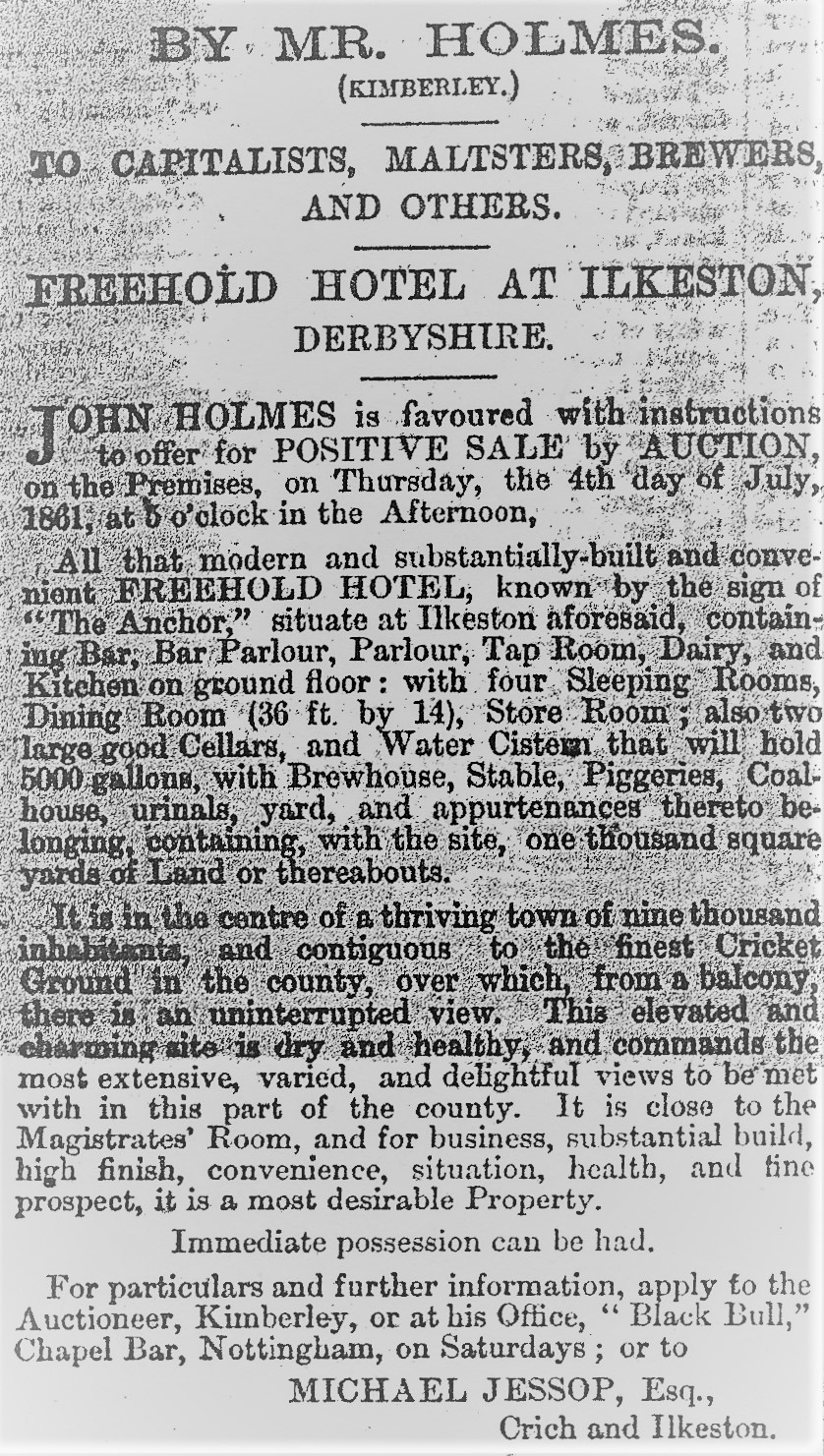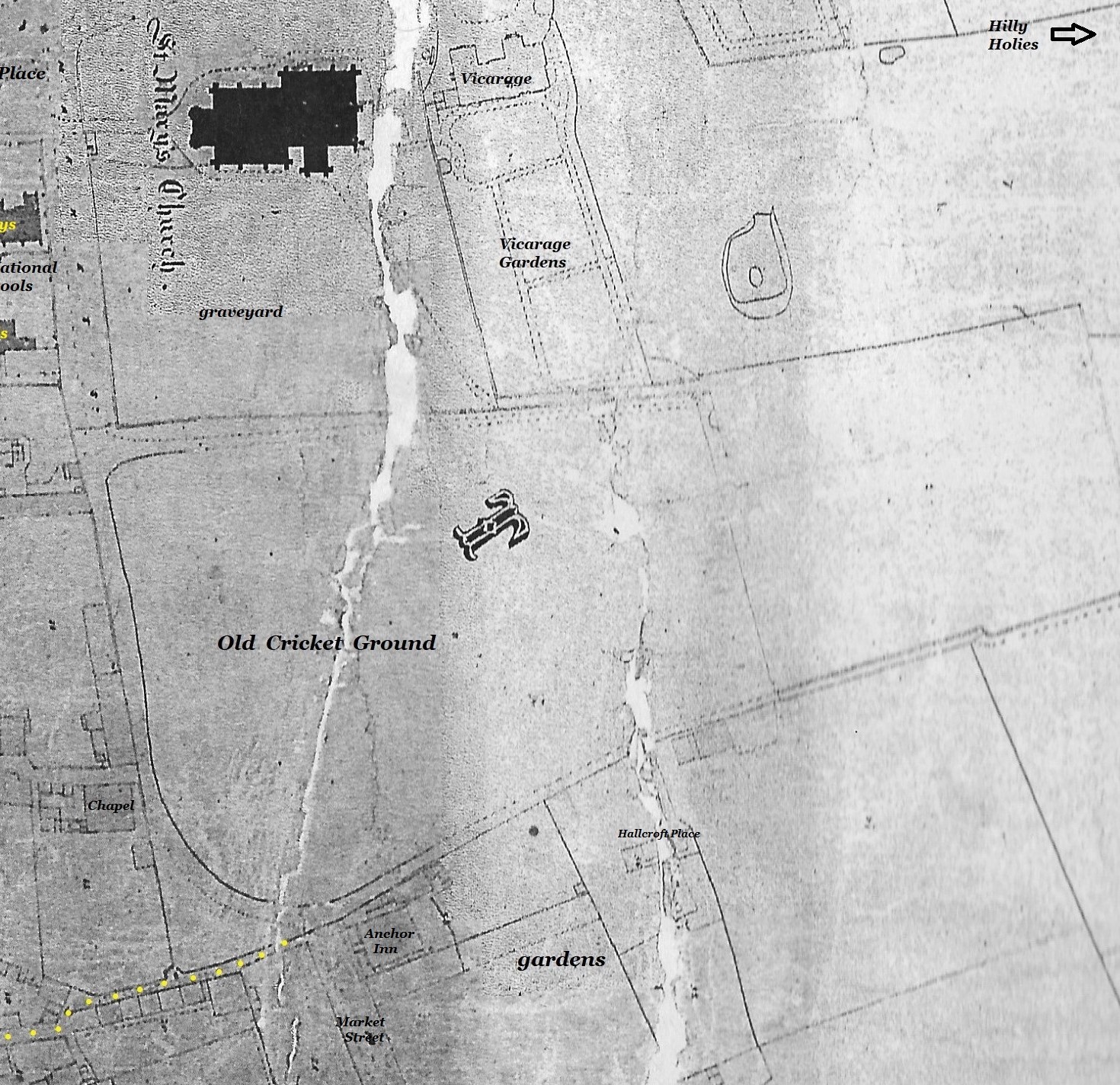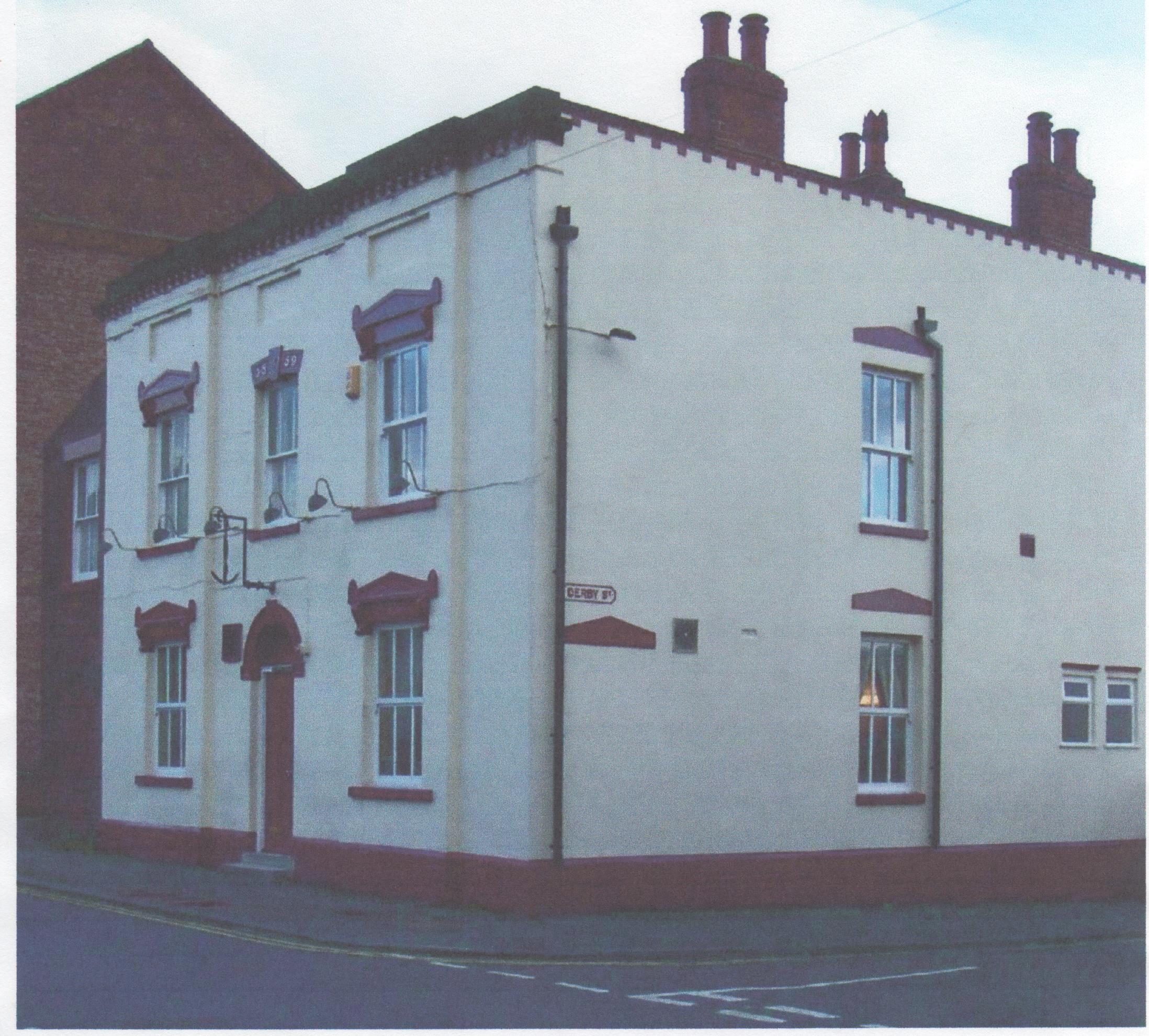Although we now leave behind the Sugg family, we remain to examine the history of their temporary family home — the Anchor Inn.
Born in Ilkeston on February 12th, 1831, lacemaker John Goddard junior was the oldest son of John and Ruth (nee Brown) and before his marriage he appears with his parents on censuses in Burr Lane, Mount Street and Brussels Terrace.
Mary Brentnall was also born at Ilkeston on August 26th 1823, the eldest child of builder Elijah and Hannah (nee Aldred) who had married at St Mary’s Church in Greasley on May 4th 1823; this was within the parish where the bride had been born. Census records show that an unmarried Mary was then taken by one or both of her parents to Middlesborough and later Birmingham — both these places had links with the Brentnall family. It was in the latter city that her mother died, on January 10th, 1855.
By the time of the 1861 census (April 7th) Mary was back in Ilkeston, at ‘the Anchor Inn’ in Market Street with her father, who was described at the innkeeper there.
A few months after this, on July 29th, 1861 John Goddard junior married Mary Brentnall at St. Paul’s Church in Nottingham.
Elijah Brentnall at the Anchor Inn
Born in 1803 Elijah Brentnall was the oldest child of John and Hannah (nee Hickton) and like his father was a bricklayer/builder.
In 1823 he married Brinsley-born Hannah Aldred, the daughter of collier Samuel and Mary (nee Ottewell) and the sister of several other ‘out-of town’ Aldreds who made their home in Ilkeston.
These included Samuel Aldred, cordwainer of White’s Yard in Bath Street, lacemaker Joseph of South Street, and Aaron, keeper of the Queen’s Head in Bath Street.
It would appear that the Anchor was not the first beerhouse which Elijah was associated with.
In 1833 the Horse and Jockey in Stapleford had Elijah Brentnall as its landlord.
Elijah Brentnall (1803-1875) … courtesy of Jeanette Brentnall
The London Gazette states that Elijah was trading as a builder at Elizabeth Cottage in Coldharbour Road, North Brixton, Surrey at the end of 1844, when he was declared bankrupt. A few months later Elijah was selling off two plots of building land, one in Barrington Road, Brixton, and the other in Denmark Street, Camberwell. At the same time he was selling two substantially newly-built genteel residences (exonerated from Land tax, forming a desirable property for investment) — they were at 5 and 6 Barrington Road in Brixton.
By 1850 Elijah had fled London and was working on a new railway station on the Churnet Valley branch of the North Staffordshire Railway at Leek. He was working as foreman for railway contractor, Mr. Salt, supervising up to 60 or 70 workmen, when a payment dispute arose between his employer and Joseph Hambleton, landlord of the Quiet Woman Inn in Spout Street, Leek. Elijah and his men were caught in the middle.
It was the custom to pay the workmen every two weeks, but they could ask for a ‘sub’ to help them in the meantime, The ‘pay office’ was Hambleton’s inn, and the victualler was often asked by Elijah, on his employer’s orders, to borrow money from the landlord which he usually repaid within a few days.
The dispute arose when Joseph argued that one payment, of nearly £20, had not been repaid. By the time this financial arguement was resolved at Staffordshire Midsummer Assizes in July 1850 — in the landlord’s favour –Elijah had moved on to Birmingham.
—————————————————————————————————————————————————-
The Ilkeston Advertiser (1914) records that Elijah “built and owned the Anchor Inn. The house was put up in three weeks, and Mr. Brentnall occupied it with his family. Earlier in his career Mr. Brentnall had been engaged abroad in bridge building”.
Elijah in Egypt
In October 1853 the Pioneer printed a letter dated June 29th 1853 which it had received from Elijah “who is employed at the Benha Bridge Works on the Egyptian Railway”.
Elijah wrote ….
“I have the works entirely under my management, and employ more than 1000 men.
“They are mostly Arabs, who are compelled to be driven to work like donkeys, with a stick or whip; the drivers are selected from the best Arabs or Turks.
“Amongst my carpenters I have Italians, Greeks, Albanians, Germans, Arabs and Maltese, all speaking different languages, so you may guess what a job I have to make them understand me; but Hiram* is getting on well with Italian and Arabic.
“There seems to have been no improvement in the customs or manners of these Ishmaelites since the days of the patriarchs. The place we are at is the identical “Land of Goshen**”. The water from Joseph’s well (down which I have been) is drawn every day by the same means as when it was first made. The corn is still trodden out by oxen.
“Before my return I think of joining a party to make a journey to Jerusalem. Tom*, myself, and Hiram are getting stout; I never was better.
“The climate though beautiful, is hot – 109 degrees in the shade. Cucumbers, melons, and water melons are here in the greatest abundance. I got one this morning as big as my head for a half-penny, full of water, and most delightful in slaking thirst.
“All well, I hope to see you in the spring of 1855”.
*Tom and Hiram were sons of Elijah.
**The reference to ‘The Land of Goshen indicates a land of peace and plenty. It was the area given to the Hebrews by Pharaoh and the place from which they left at the time of the Exodus.
Robert Stephenson was engineer-in-chief to this Egyptian railway, the first section of which was completed and opened in 1855. The wrought-iron tubular Benha Bridge over the Nile on this line between Alexandria and Cairo had ten arches, each of 80 feet (except the two centre ones of 60 feet), was 870 feet in length and carried the railway on the top. The centre was designed to swing open to allow better access for river navigation.
At this point … my thanks to Jeanette Brentnall who has made a couple of contributions in the Comments Section.
Jeanette, working with others, has put onto line, transcripts of the diaries of Elijah Brentnall and his son Hiram, both of which provide much more information on the Brentnall family history, their work in Egypt and their life in Australia.
The site can be found at http://www.Scribd.com …. well worth a visit.
The Anchor Inn In Market Street.
Brother George Brentnall (1811-1897)
Like several of the male members of this Brentnall family Elijah’s brother George was also a builder.
He was born on October 28th 1811 at Ilkeston, but shortly after his marriage to Mary Cark, a Riddings lass, on November 25th 1833, he moved to his bride’s home town, to trade as a builder. ( She was the daughter of iron miner Charles Clark and Sarah (nee Chamberlin) ?)
George was a member of the Wesleyan Chapel but the 1849 schism in that organsisation caused upheaval in his religious life. Feeling that he now had to choose, he took the side of Messrs. Griffith, Everett and Dunn and followed the path of the Wesleyan Reformers. With the inaugeration of the Free Methodists around 1857 he was one of the first to join them and remained with them until his death. In his younger years (a relative term !!) George worked actively in their cause; alternatively, on his 80th birthday he donated a £100 legacy to his Free Church in Riddings, one of a series of donations which he made to his chapel.
George and Mary had 12 children, all except Sarah Ann surviving into adult life. Eldest child Frederick Thomas (1835-1925) was sent out to Australia on October 1st, 1863 as a Wesleyam minister but health difficulties led him into a different path — in a political and literary direction. At the time of his father’s death he was Chairman of Committees of the Legislative Council in Brisbane.
George’s wife Mary died on June 22nd 1890 at West Riddings Cottage, High Street, aged 82. George died at the same home on January 16th 1897, aged 85. He was buried at the UMF Church at Birchwood, Somercotes.
John Goddard at the Anchor Inn
Harrison, Harrod, & Co’s Directory of 1860 records Mary Brentnall, daughter of Elijah and Hannah (nee Aldred) as a beer seller of Market Street, almost certainly at the Anchor Inn.
In mid-1860 Elijah was granted a licence to trade as a victualler. The 1861 census shows him at the Anchor Inn, as innkeeper, with unmarried daughter Mary.
His wife Hannah had died in Birmingham in January 1855 and was interred at the General Cemetery there.
Two months after this census — in May 1861 — the Anchor Inn was advertised for sale or to let in the Pioneer. Throughout June it was still being advertised and then on July 4th it was to be sold by auction on that very day.
The Inn was described as a freehold hotel with bar, bar parlour, parlour, tap room, dairy and kitchen on the ground floor; with four sleeping rooms, dining room (36ft x 14ft), store room; two large cellars and water cistern holding 5000 gallons, brew house, stable, piggeries, coalhouse, urinals, yard, and appurtenances containing about 1000 square yards of land.
Notice that the first feature to emphasise was its position, ‘contiguous to the finest Cricket ground in the county, over which, from a balcony, there is an uninterrupted view’.
From its rear the height and location would have provided extensive and ‘delightful’ views over the countryside. But note that the balcony seems to have been there before the arrival of John Goddard.
This sale roused the Pioneer to comment on the ‘free-guzzling’ system of several recent auctions which had become a centre for ‘bacchanalians’ rather than a place of business. It appears that the bidding had been enlivened by some members of the audience who had swallowed too much intoxicating liquor.
By the following week the Inn was again being offered to let with immediate possession, being described as ‘a newly-erected…house…to which an old licence has recently been granted….apply to Mr. Brentnall’.
Had it failed to sell at the auction?
Two weeks after this and John Goddard, ‘builder of East Street’, was offering a house to be let in Burr Lane, with four bedrooms, garden and plentiful supply of water. Was he moving from this home to take over the Anchor Inn?
At the same time another auction was advertised on July 29th at the Anchor ‘Hotel’, this time to sell off the whole of the brewing plant, ‘the house having been taken for private residence; the whole will be sold entirely without reserve’.
On the same day as this proposed auction John Goddard and Mary Brentnall were married at St. Paul’s Church in Nottingham.
It was probably at this time that Hubert Henri Sugg and his family rented the house and remained there until their departure to the ‘Steel City’ in South Yorkshire in 1864.
Adeline points this out in her letters: “When Mr. H. H. Sugg left the house a licence was granted to Mr. John Goddard, son of John Goddard, Burr Lane”. She goes on to write that “(The Anchor Inn) became very popular with cricketers, etc., and John had a balcony added to the side of the house overlooking the Cricket Ground, where his customers could enjoy their drinks while watching the prowess of the cricketers”.
The map on the right is adapted from the Local Board map of the mid-1860’s.
Between the Old Cricket Ground and the Anchor Inn is a pathway which was later named as Hallcroft Road now a cul-de-sac.
On the other (south) side of the Inn is a roadway, later named as Derby Street (also a cul-de-sac and not to be confused with the much longer Derby Road).
The chapel shown is the Old Cricket Ground Chapel where both Mary Brentnall and John Goddard jnr were baptised.
Hallcroft Place, a cluster of three or four households and which appears on early censuses, is also shown.
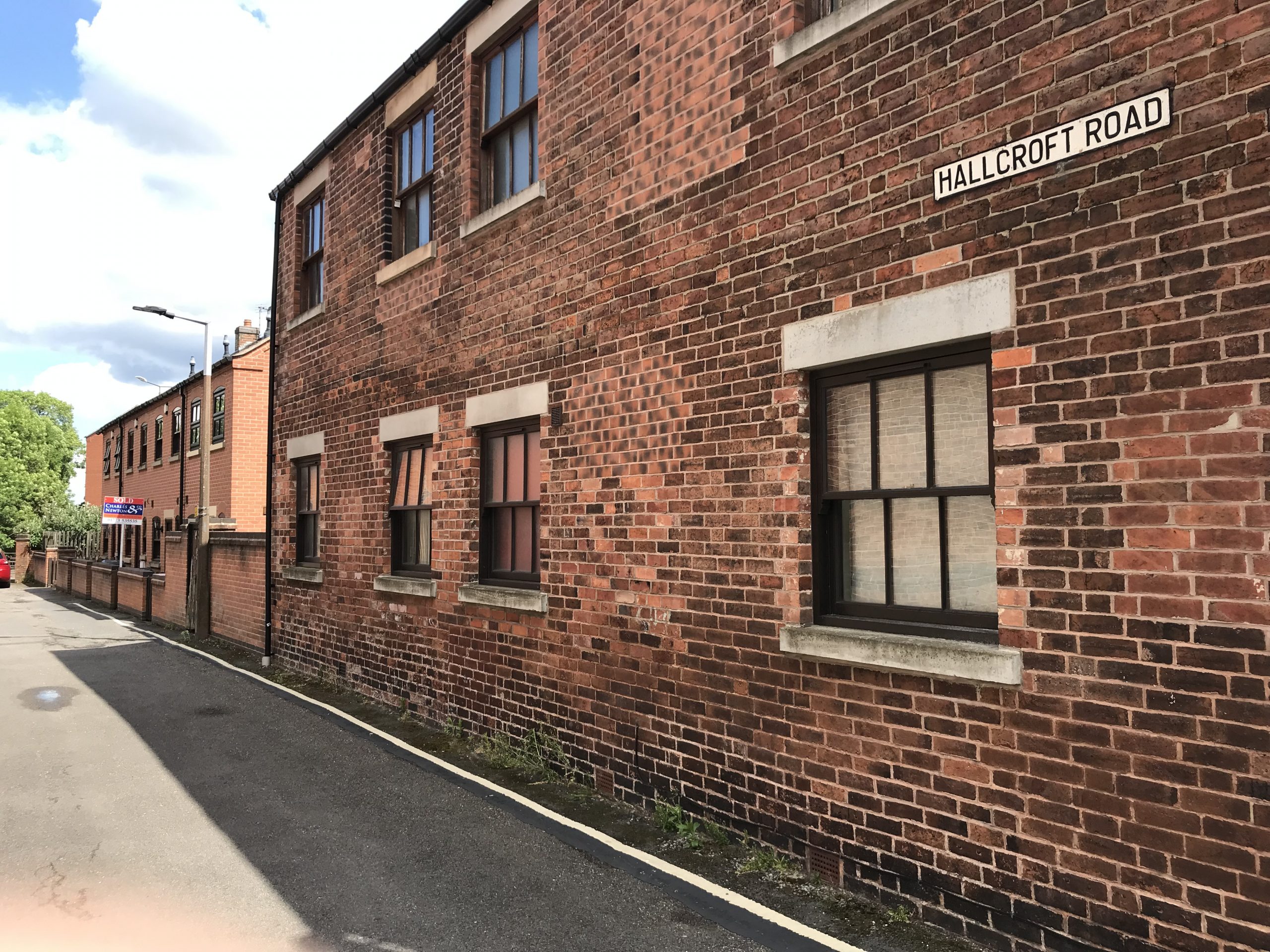
On the right of this photo is the Anchor Inn site; the spectator balcony overlooking the old Cricket Ground would most probably have been at the rear. The photographer is standing in Market Street, looking eastwards down Hallcroft Road (2022)
In 1871 John was landlord of the Anchor Inn. In August 1869 and again in August 1870 he had been refused a victualler’s license, both times as owner of the Cricketer’s Arms (a previous name for the Anchor). This was not the first Ilkeston public house to be labelled with that name as John Paxton could testify.
By 1873 the Rutland Cricket Club had fenced in the old Cricket Ground and was charging for admission.
But what to do about the spectators on the Anchor Inn balcony who had a free view of the cricket matches?
In July and just prior to the county cricket match at the ground the club had erected poles and canvass, to obstruct the view. This had led to much acrimony, some stone-throwing, one broken window, and of course a court case – what else?
A compromise was sought and, despite protestations, the Inn eventually agreed to pay an annual fee of £2 to the club and so avoid the view being blocked by further hoardings.
In September 1874 John was refused a licence to sell wine and spirits to be consumed on the Inn’s premises.
And in 1875 came another refusal.
In September 1876 John applied once more for a victualler’s licence at Heanor Brewster Sessions.
At that meeting some interesting detail of the history of the inn was revealed …. it was argued that the Anchor had at one time such a licence but that the then landlord — Elijah Brentnall? — had to give up the business because of ill health, and did not apply for a transfer of his licence.
The house was then let to solicitor Hubert Henri Sugg who subsequently left for Sheffield in 1864.
Thereupon a beerhouse licence was obtained for the house by William Attenborough and it had been a beerhouse ever since, having now been transferred to John. The latter now suggested that granting him a spirit licence would confer ‘a great benefit on the neighbourhood’. A new street from the Market Place through to Nottingham Road was about to be opened and this was where the Anchor Inn stood.
The Justices were not persuaded however and John’s application was refused.
And he was refused once more in 1877.
With John Fish, the Parish Clerk, John developed and improved at least part of Derby Street in 1874-75, and this were extended in 1881.
The Goddards left the Anchor Inn about 1882 and eventually went to live in a new house at 13 Graham Street.
John subsequently worked as a lacemaker at Hewitt’s factory on Heanor Road and then at Sudbury’s factory on Market Street.
Mary died in Graham Street in November 1895 whereafter widower John was joined by his niece, Evelina Straw, daughter of Norman and John’s eldest sister, Catherine (nee Brown alias Goddard).
Evelina was his housekeeper until John died at 13 Graham Street in March 1914, aged 83.
Other landlords at the Anchor Inn
In 1882 Eli Wardle was landlord and like his predecessor he quickly applied for a spirit licence … and like his predecessor he was …… (fill in the gap!!)
And in August 1883 at the licensing business of the Heanor Petty Sessions … guess what?!!
In February 1884 the licence was transferred to John Ridge Lee and at the beginning of September 1884 John, already a holder of a beer licence, applied for a full licence on the grounds that the inn was now on practically a main thoroughfare from Ilkeston to Nottingham. A change of licence would thus be a great convenience in what was now a very populous area.
He had no more luck than his predecessor. The magistrates refused the request.
In April 1886 the licence passed from John Ridge Lee to William Batty (until 1889 ?) However in October 1887 the licence was temporarily awarded to George Severn.
In August 1889 keeper George Severn tried his luck and applied for a full licence. Another refusal.
And the same in September 1890. (At this time the Inn was owned by The Crompton Brewery Co.)
A month later George had to attend a different court — the Court for the Revision of the voters’ lists for Ilkeston at the Town Hall. This was held regularly, to hear the cases of anyone who felt they were entitled to the vote but had been missed off the voters’ list. George’s two sons, Joseph and Aaron, both young colliers now over the age of 21, applied for a Liberal lodger’s vote, as they both lived with their father at the Anchor Inn. On behalf of the Conservatives, Edwin Trueman disputed their claim, and wanted their father to attend court and swear that they were ‘tenants’ of his. George did attend, and, very unusually, was asked to swear on his oath that he would tell the truth. Such an unusual request in fact, that a Bible could not be found !! — that is, until the Town Hall caretaker turned up with one. Whereupon George was duly sworn, gave his evidence, conclusively, and his sons were given their ‘vote’.
In August 1891 came the annual ritual of George Severn turning up at the Brewster Sessions, to apply for a full licence. Since last year there had been extensive building on either side of the inn, and with a full licence a better class of customer could be attracted than could be expected at a beerhouse. Sadly though, another refusal !!
And then, in August 1892, George was back at the Licensing hearings, applying as usual — and with the same result !!
And another one in August 1894. But George was granted a wine licence for the Inn.
In August 1896, accompanied by a petition signed by 297 persons, George applied again for a full licence. And this time he was not refused. Instead the case was adjourned!!
But in October George was granted his full licence!! By this time he had been landlord for nearly nine years. At this licensing hearing some of the history of the Anchor Inn was revealed. It had originally been occupied as a hotel with a full licence. This would be in 1860, with landlord Elijah Brentnall, helped by his daughter Mary, (and shortly after its erection in 1859). While Elijah was away in India the premises were then leased by solicitor Hubert Henri Sugg who preferred to use it as a private residence and who allowed the licence to lapse. This would be from 1861 to 1864, when Hubert Henri and his family left Ilkeston for Sheffield. Elijah was still the owner and apparently was greatly annoyed by the loss of the licence. Subsequently, on Elijah’s return, the premises were granted a beer licence, initially to John Goddard. And thereafter followed a succession of unsuccessful applications for a full licence for the Anchor beerhouse until George Severn finally got one in 1896. At that time it was only tied for barrelled beer and stout.
George Severn and his wife Eliza (nee Pounder) were at the inn until 1906. Then Arthur Watchorn and his family moved in until 1922. They were followed by Ernest Webster (1922-1930), then Arthur and Sarah Jane Straw. When Arthur died in 1936, his widow married William Brecknock and continued at the inn until 1939.
The Anchor Inn at the corner of Market Street and Derby Street
———————————————————————————————————————————————————-
We now return to South Street.

